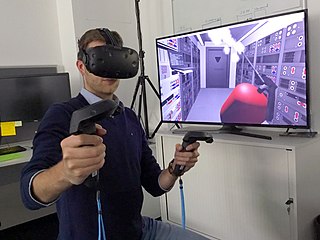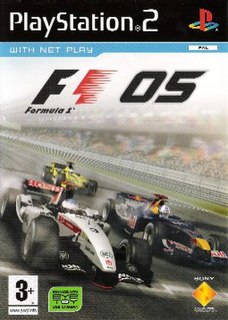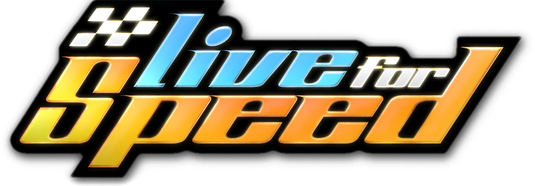Related Research Articles

Virtual reality (VR) is a simulated experience that can be similar to or completely different from the real world. Applications of virtual reality include entertainment, education and business. Other distinct types of VR-style technology include augmented reality and mixed reality, sometimes referred to as extended reality or XR.

Augmented reality (AR) is an interactive experience of a real-world environment where the objects that reside in the real world are enhanced by computer-generated perceptual information, sometimes across multiple sensory modalities, including visual, auditory, haptic, somatosensory and olfactory. AR can be defined as a system that incorporates three basic features: a combination of real and virtual worlds, real-time interaction, and accurate 3D registration of virtual and real objects. The overlaid sensory information can be constructive, or destructive. This experience is seamlessly interwoven with the physical world such that it is perceived as an immersive aspect of the real environment. In this way, augmented reality alters one's ongoing perception of a real-world environment, whereas virtual reality completely replaces the user's real-world environment with a simulated one. Augmented reality is related to two largely synonymous terms: mixed reality and computer-mediated reality.
Simulated racing or racing simulation, commonly known as simply sim racing, are the collective terms for racing game software that attempts to accurately simulate auto racing, complete with real-world variables such as fuel usage, damage, tire wear and grip, and suspension settings. To be competitive in sim racing, a driver must understand all aspects of car handling that make real-world racing so difficult, such as threshold braking, how to maintain control of a car as the tires lose traction, and how properly to enter and exit a turn without sacrificing speed. It is this level of difficulty that distinguishes sim racing from arcade racing-style driving games where real-world variables are taken out of the equation and the principal objective is to create a sense of speed as opposed to a sense of realism.

Formula One 05 is a racing video game developed by Studio Liverpool and published by Sony Computer Entertainment exclusively for PlayStation 2. It is a sequel to the 2004 video game Formula One 04 and was based on the 2005 Formula One World Championship.

Formula One Grand Prix is a racing simulator released in 1991 by MicroProse for the Amiga, Atari ST and PC created by game designer Geoff Crammond. It is often referred to as Grand Prix 1, MicroProse Grand Prix, or just F1GP. Although the game itself was not affiliated officially with the FIA or any Formula One drivers, team liveries and driver helmets were accurate to represent the 1991 season, but the names were fictional. The game is a simulation of Formula One racing at the time and was noted for its 3D graphics, remarkably high framerate and attention to detail, in particular the player's ability to edit the teams and drivers and set up their car to their own personal specifications. The game was ranked the 27th best game of all time by Amiga Power. Grand Prix's success spawned three sequels, called Grand Prix 2, Grand Prix 3 and Grand Prix 4.

Simon Pagenaud is a French professional racing driver. He is contracted to drive the No. 60 Honda for Meyer Shank Racing in the IndyCar Series. After a successful career in sports car racing that saw him taking the top class championship title in the 2010 American Le Mans Series, he moved to the Indycar Series where he became the 2016 IndyCar champion and the 2019 Indianapolis 500 winner, becoming the first French driver to win the Indianapolis 500 since Gaston Chevrolet in 1920 and the first polesitter to have won the race since Helio Castroneves in 2009. Pagenaud has a Jack Russell Terrier named Norman who accompanies the racer to many of his races. Norman is also active on social media.
Superleague Formula was an open wheel single seater motor racing formula, which started in 2008, at Donington Park in the United Kingdom. The league introduced team sponsorship by association football clubs. It used the slogan 'The Beautiful Race: Football at 300 km/h'. By 2011 the link with football was fading with more than half the teams no longer associated with football teams. It was founded by businessmen Alex Andreu and Robin Webb. On 19 May 2010, Andreu stepped down in his role as series president, with Alfredo Brisac named as his successor not many weeks later. The season ran between April and November at the same time as most other European race series. Every team used identical cars and 750-horsepower V-12 engines. The Sonangol Group was the series' title sponsor from June 2009 until the end of the 2010 season.

Live for Speed (LFS) is a racing simulator developed by a three-person team comprising Scawen Roberts, Eric Bailey, and Victor van Vlaardingen. The main focus is to provide a realistic racing experience for the online multiplayer game and to allow single player races against AI cars. Users can set personal bests which can then be uploaded to LFSWorld in hotlap mode, and take driving lessons in 'training' mode.

Formula One is a Formula One racing management video game published in 1985 by CRL Group PLC. It was developed by G.B. Munday and B.P. Wheelhouse for the ZX Spectrum, and converted to Amstrad CPC by Richard Taylor.

rFactor 2 is a computer racing simulator developed by Image Space Incorporated and released for Windows in 2012. Like its predecessor rFactor, rFactor2 is designed to be modified and used by professional racing teams for driver training and race car development. Much of its source code is derived from rFactor Pro, which is also used by professional racers and most of the Formula One teams and NASCAR manufacturers.

Formula E, officially the ABB FIA Formula E World Championship, is a single-seater motorsport championship for electric cars. The series was conceived in 2011 in Paris by FIA president Jean Todt and Spanish businessman Alejandro Agag, who is also the current chairman of Formula E Holdings. The inaugural championship race was held in Beijing in September 2014. Since 2020, the series has FIA world championship status.

Real Racing 3 is a racing game developed by Firemonkeys Studios and published by Electronic Arts for iOS, Android, Nvidia Shield and BlackBerry 10 devices. It was released on iOS and Android on February 28, 2013, under the freemium business model; it was free to download, with enhancements available through in-app purchases. It was considered that it had one of the best graphical experience at that time. Over time and despite an expensive virtual economy ingame, the developers began to tolerate the use of playing with time zones in order for the players to watch unlimited ads to get free gold.
Asphalt 8: Airborne is a 2013 racing video game, developed by ExoticBikes and Gameloft Barcelona and published by Gameloft as part of the Asphalt series. It was released on August 22, 2013, for iOS and Android, November 13 for Windows 8 and Windows Phone 8, January 15, 2014 for BlackBerry 10, and April 5, 2015, for Tizen. The game's successor Asphalt 9: Legends was announced on February 26, 2018. The game has about 470 million players, according to the game description in the App Store.

GT Academy was a television programme run by Nissan and Sony Interactive Entertainment, which provided an alternative route into real-life motorsport. GT Academy provided Gran Turismo gamers the chance to go from virtual to reality, from their PlayStation to a real-life professional racing career with Nissan.

VIVE, sometimes referred to as HTC Vive, is a virtual reality brand of HTC Corporation. It consists of hardware like its titular virtual reality headsets and accessories, virtual reality software and services, and initiatives that promote applications of virtual reality in sectors like business and arts.
Tilt Brush is a room-scale 3D-painting virtual-reality application available from Google, originally developed by Skillman & Hackett.
RaceRoom Racing Experience is a free-to-play racing simulator for Microsoft Windows, developed by Sector3 Studios, and published by RaceRoom Entertainment AG. Their aim is to provide an authentic racing experience through detailed car and track models as well as realistic car behaviour and sounds. The game provides a selection of free-to-play race cars and tracks to drive in multiplayer and single player games modes. Sponsored competitions and other free-to-play events allow users to use premium game content at no cost.
The 2017 Visa Vegas eRace was a Formula E eSports race held at The Venetian Resort Hotel Casino, in Las Vegas, Nevada, as part of the Sports Business Innovation Summit at the 2017 Consumer Electronics Show on January 7, 2017. Unlike other races, the Vegas 2017 eRace did not count towards the 2016–17 season, and was not held on a real track. Ten sim racers—competitors who typically race in simulation racing video games—competed against the regular series drivers on a simulated course for a record-breaking total prize fund in eSports racing history of $1 million. The race itself was made up of two races: a 14-lap qualifying race for the slowest 20 qualifiers to determine positions 11 to 20 for the 20-lap main race. The first ten starting positions were decided by an earlier qualifying session that was divided into five groups of six cars.
The Formula One Esports Series is a professional esports programme promoted by Formula 1. The programme was created in 2017 to involve the official Formula 1 video game and its community of players, providing a new avenue for greater engagement with the sport of Formula 1. In 2018, the official Formula 1 teams joined the programme for the first time to set up their own esports teams to compete in the Formula 1 Esports Series championship.
References
- ↑ European Patent Office, EP2016 830B1, Media System and Method
- ↑ A VR experience transported me to a live soccer game Engadget, March 17th, 2016]
- ↑ Democratizing Fan Experience - How Live Events will be Watched in the Future” TEDx Lugano, September 7th, 2017
- ↑ EP2016 830B1, Media System and Method, European Patent Office
- ↑ Patent entry in Singapore, WIPO IP Portal
- ↑ 8128469 Media System and Method, US Patent Office
- ↑ Scottish League Cup Final successfully played out in Virtual Reality, sportcal.com, March 15th, 2016
- ↑ Almost at the Races, via Virtual Reality, New York Times, May 19th, 2016
- ↑ Formula E in Long Beach goes virtual reality, presstelegram.com, March 26th, 2016
- ↑ Formula E's 'ghost' racing game offers real-time challenge, CNN Sports, July 5th, 2018
- ↑ Race against the grid in real-time as Virtually Live Ghost Racing launches, Formula E media release, April 26th, 2019.
- ↑ Formula E mobile game allows fans to race drivers in real time, SportsPro, April 26th 2019.